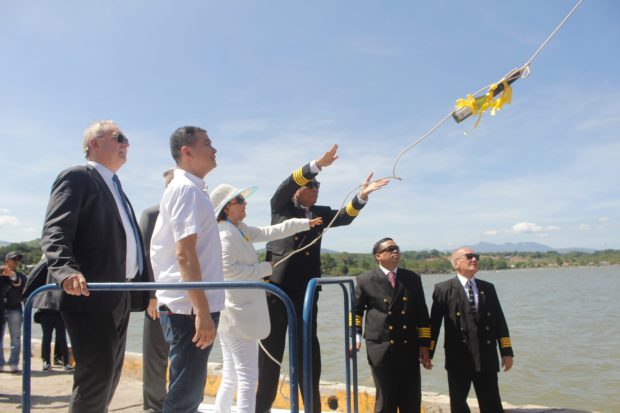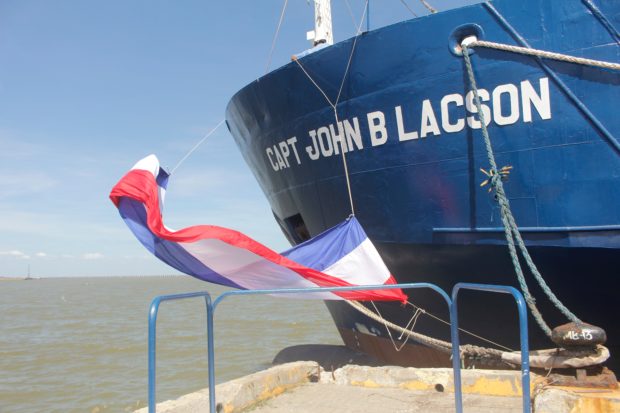Maritime school unveils training ship
A local maritime university has unveiled a training ship that it hopes would equip students with skills needed to pursue careers as seafarers.
In a ceremony on Thursday at the Port of Capinpin in Orion, Bataan, officials from the John B. Lacson Foundation Maritime University (JBLFMU) and the JBL Maritime Vanguard Services Inc. showcased the M/V John B Lacson to the public.
The vessel was named after the distinguished captain who established a review center in his hometown in Iloilo, which later became the Iloilo Maritime Academy in 1948. The scholl eventually became the JBLFMU in 1970 under the leadership of Lacson’s youngest daughter, Dr. Mary Lou Lacson-Arcelo.

Officials of the John B. Lacson Foundation Maritime University (JBLFMU) and the JBL Maritime Vanguard Services Inc. unveiled the training ship to the public on November 8, 2018. PHOTO by Gabriel Pabico Lalu/INQUIRER.net
According to Arcelo, the President Emeritus of JBLFMU, the purchase of the training ship is a realization of the school’s aspirations, although she admitted that her father would have not imagined his “review center’s” achievements.
“You know, Captain Lacson is a seaman, and he was the founder of the school. Now, he never probably expected that his school would even be a university,” Arcelo told INQUIRER.net in an interview.
Article continues after this advertisement“I don’t think he even expected this, but we at John B. Lacson (university) who are living his legacy […] we know that if he were alive, he would be very proud of having this school as it is now,” she added.
Article continues after this advertisementShe added that Lacson, a seafarer who lived at a time when masculinity and macho ideologies reign supreme in the industry, might not be able to hold back tears if he were alive today to see the training ship.
“He will be crying with joy. My father, he is a brave and very courageous man, he says he has salt in his blood, but he can very sentimental,” Arcelo noted.
Humble beginnings
Captain Vicente Fedelicio, Chair of JBL Maritime Vanguard Services and a JBLFMU alumnus, said he expects students to learn more by manning the ship themselves, amid an increasing demand for seafarers all over the world.
“During my time in the university, while taking BSMT [Bachelor of Science in Maritime Transportation], I would say that we were quite privileged to have a small training ship at the Iloilo Maritime Academy. With that we learned a lot,” Fedelicio told INQUIRER.net.
Fedelicio said that in the past, students would be required to do on-the-job training at shipping lines. But they were limited to observing what happens in the deck and other areas. With its own training ship now, students will have a “hands-on” experience.
“On the training ship, you are allowed to touch, you are allowed to fiddle, and this will serve as their laboratory,” he added.
Daishel Balsomo, an alumna of JBLFMU who graduated in 2015 with a degree BS Cruise Ship Management (BS-CSM), students like her were paying shipping lines a huge sum of money to take a look at the equipment.
“During my college years, a shipping line is letting us pay a certain amount for our training that is good for five to seven days […] (around) P28,000 to P30,000 (for Cruise Ship Management students),” Balsomo said.
But for Marine Engineering, Marine Transportation, she said the fee is around P30,000 to P35,000,” she added.
She also noted that students like her fail to fully enhance their skills set with this scheme.
“The only difference is that when you go onboard a commercial vessel, you don’t get a hands-on training experience,” Balsomo said, referring to learning to manage equipment and using electronics.
For Fedelicio, the training ship would help produce highly-qualified and better Filipino seafarers.
“I am very sure that this will improve the educational training, specifically of JBLFMU (students),” he added.
Acquiring an old boat
Managers of the M/V John B. Lacson said that the 71.92 meter-long vessel was originally a German bulk container ship built in 1977. JBL Maritime Vanguard Services converted it into a training ship with a crew of 33. It can accommodate 200 trainees at a time.
Dr. Arend Brügge, chief executive officer of Vega-Reederei, assured that the 41-year old ship is still in a good condition. He even claimed that the ship, which was made of German steel, will fare better than new boats.
“She’s 41 years old, so how can this ship get so old at this condition? There are several explanations. It’s German steel, that is the most important thing, it is much really better than the other steel we find on our today’s ships,” Brügge said.
“The ship has been constructed extra strong, because she was designed for trade in the Artic (region), during winter times […] the steel is thicker,” he added.
But aside from its robust structure, officials said there is a practical reason in acquiring an old boat — to teach students the basics of operating a boat.
“The reason why we acquired an old boat, was to teach the students the hard way using old machinery, because if we used a new, fully automatic boat, they would learn less,” Captain Jonathan Villaflor, Master of M/V John B. Lacson, said in an interview with INQUIRER.net.
They added that the ship remains environment-friendly as it uses diesel instead of bunker fuel.
“I can assure you that this vessel is more environment-friendly than the other vessels that are coasting here because we’re not using bunker fuels. The generators are running, but you can barely see smoke coming off because we are using diesel fuels,” Villaflor explained.
“The pipings, we have replaced everything, as if it were a new ship. But of course, in this case, this will be more expensive to operate compared to a bunker-run vessel,” he added. /ee
